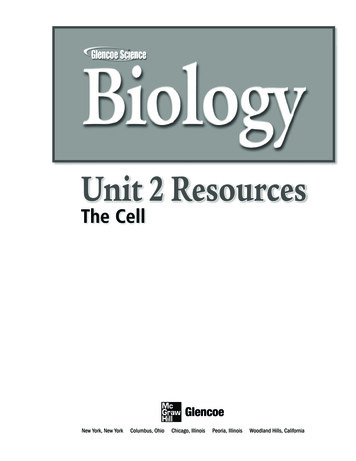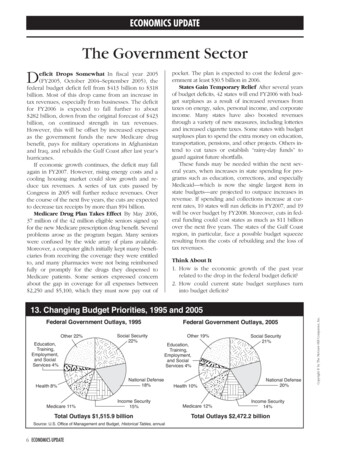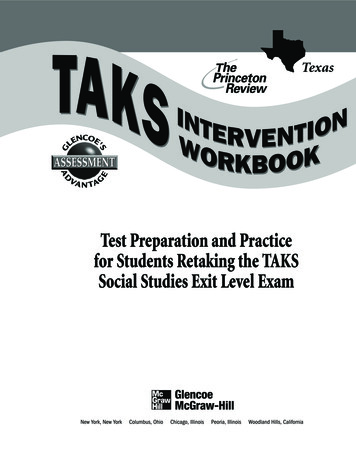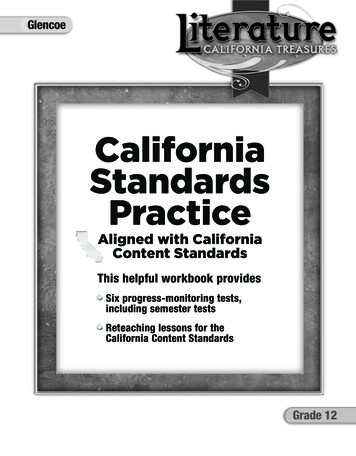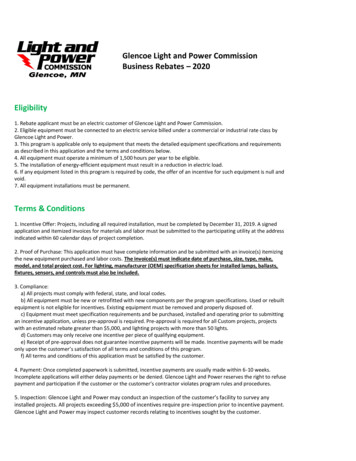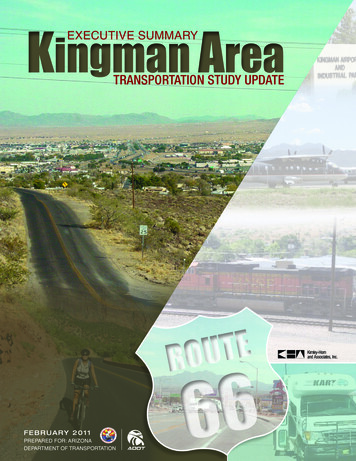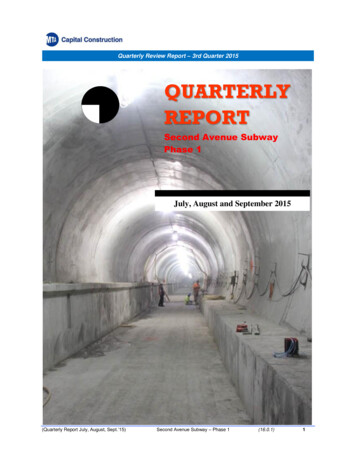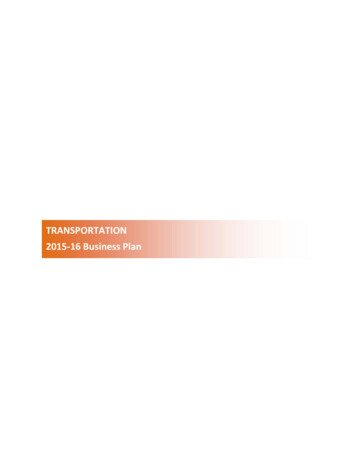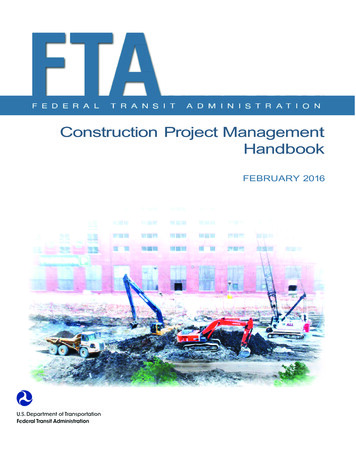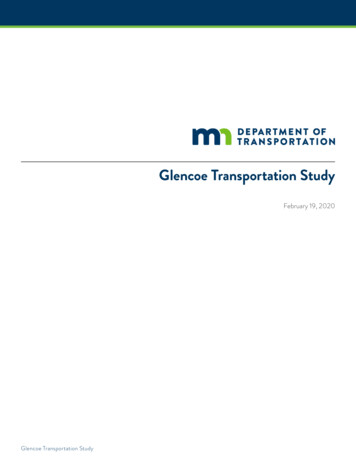
Transcription
Glencoe Transportation StudyFebruary 19, 2020Glencoe Transportation Study
Report prepared by:Study partners engaged:Acknowledgments:Mark Larson – City of GlencoeDan Ehrke – City of GlencoeCory Neid – City of GlencoeWes Olson – City of GlencoeAllen Robeck – City of GlencoeJohn Rodeberg – SEH (Engineer for City of Glencoe)Doug Krueger – McLeod CountyJohn Brunkhorst – McLeod CountyNeal Brady – Miller ManufacturingBrian O’Donnell – Priority 1 Metrowest RealtyMark Wegner – Twin Cities & Western Railroad CompanyShauna Gruber – Twin Cities & Western Railroad CompanyLindsey Bruer – MnDOT District 8Mandi Lighthizer-Schmidt – MnDOT District 8Megan DeSchepper – MnDOT District 8Leif Garnass – SRF Consulting GroupJono Cowgill – SRF Consulting GroupAaron Vacek – SRF Consulting GroupGlencoe Transportation Study
Table of ContentsIntroduction.1About the Study.1Study Goals.2Study Process.2Engaging the Community .3Opportunities for Public Input .3Stakeholder Workshops .4Community Open House Events .4Communications.5What we Heard.5Feedback for Hwy 212.5Feedback for Hwy 22 .5Hwy 212 Safety Improvements.6Key Needs and Considerations.6Hwy 212 and Chandler Ave (Hwy 22).6Hwy 212 and Morningside Dr (CR 15).7Falcon Ave and CR 69 Intersections with Hwy 212 .8Recommended Improvements .9Hwy 212 and Chandler Ave (Hwy 22).9Hwy 212 and Morningside Dr (CR 15). 10Falcon Ave and CR 69 Intersections with Hwy 212 . 11Why we use Roundabouts.12Why we use J-Turns .13Hwy 22 Route Considerations .14Key Needs and Considerations.14Range of Potential Hwy 22 Routes.15Hwy 22 Routes Recommended for Future Environmental Review .16Potential Impacts and Environmental Risks. 17Summary of Routes.18Roadway Ownership Changes.19Next Steps .20Hwy 22 Route Considerations .21Hwy 22 Route Considerations .21Funding Considerations .22AppendicesAppendix A: Highway 212 Intersection Control Evaluation (ICE) ReportsAppendix B: Highway 22 Route EvaluationAppendix C: Roadway Ownership EvaluationAppendix D: Agency SupportGlencoe Transportation Study
Figure 1: Study CorridorsIntroductionThe Minnesota Department of Transportation (MnDOT),the City of Glencoe and McLeod County have partnered to improve the safety of intersections along Highway (Hwy) 212 and Hwy 22 (see Figure 1), and to lookat options for Hwy 22 in the Glencoe area. There havebeen several planning and preliminary engineering studies completed in the Glencoe area since the late 1990s.The latest report, the Glencoe Transportation PartnershipStudy, was completed in 2003 and developed a coordinated transportation system plan for the Glencoe areaamongst State, County and City interests. At the time,it was anticipated there would be unprecedented growthin the Glencoe area and there would be a need for majortransportation system improvements over the following20 years. The study made recommendations for specific projects including interchanges along Hwy 212 and thepotential realignment of Hwy 22.Since the completion of the 2003 study, much of thedevelopment projected for Glencoe did not occur asplanned, due to larger economic trends across Minnesota and the nation. Additionally, funding realities for stateand local transportation funding have made preservationof the existing system the focus of transportation dollars.Therefore, some of the project recommendations in theGlencoe Transportation Study2003 study, such as interchanges at every intersection,are no longer feasible given the current transportationfunding realities. The purpose of this study is to updateprevious plans to refect the current and future transportation system needs and to develop and to identify a newset of recommendations from which to base future transportation investments.About the StudyThis planning study is the frst step in addressing safetyconcerns on Hwy 212 and looking at options and considering the feasibility of changes to the route of Hwy 22in Glencoe. Hwy 212 serves as a mobility corridor in theregion with four key intersections serving the Glencoecommunity. Hwy 22, after passing through downtownGlencoe, connects to Hwy 212 at one of these key intersections (Chandler Ave). Robust community engagement was conducted throughout the study. Eforts werecarried out to gather input on issues and concerns regarding Hwy 212 and Hwy 22. Hwy 212 safety improvementalternatives and Hwy 22 feasible routes were presentedto residents, business owners, local and regional roadwayusers, elected ofcials and stakeholders.1
Study GoalsPhase 1 included verifying the purpose and need for conducting the study and identifcation of issues and priorities.The study partners identifed study goals, as shown in Fig- This included reviewing previous area studies, collectingure 2, based on issues and needs for both Hwy 212 and trafc counts and conducting an evaluation of the area’sHwy 22. These goals, which were supported by commu- crash history and land use and development plan. An imnity input, guided the overall study process.portant outcome of this frst phase was to understandhow both Hwy 212 and Hwy 22 function today and unFigure 2: Study Goalsderstand future changes that may impact the roadways.Improve the safety of intersections along Hwy 212 and Study goals were also established in this frst phase.1Hwy 22Phase 2 included identifying several potential intersection control and access alternatives for key intersec2tions along Hwy 212 and potential re-route options forDevelop a plan that outlines access along Hwy 212 and Hwy 22 through and around Glencoe. Each intersection3 Hwy 22alternative was evaluated to determine its efectivenessin addressing current issues and concerns, not only for4 Study the current route of Hwy 22cars and trucks but also for walkers and bikers. Routes forHwy 22 were evaluated relative to the identifed needsDetails regarding the technical work completed and input of the roadway and to potential environmental risks. Imfrom the community as they relate to these goals are in- provements developed for both roadways were a resultcluded in later sections of this report.of public and stakeholder input received, the engineeringanalyses completed, and the history of previous transporStudy Processtation studies completed for the Glencoe community.Improve safety for pedestrians and bicyclists along Hwy 212and Hwy 22The study was conducted in three phases as shown inFigure 3. Study oversight and decision-making was ledby a Project Management Team (PMT) consisting of thestudy partners, the City of Glencoe, McLeod County andMnDOT. This team was supported by a Technical Management Team (TMT). The TMT included leaders of MnDOT’s District 8 functional staf and staf from both theCity of Glencoe and McLeod County.Phase 3 included identifying the recommended alternatives for Hwy 212 along with next steps relative to pursuing future funding. Re-routing Hwy 22 is a long-rangegoal for the Glencoe community – this phase identifedpotential routes for Hwy 22 and how these can be incorporated into a future environmental review. Currently,there is no funding to complete the environmental review.Figure 3: Study ProcessGlencoe Transportation Study2
Engaging the CommunityRobust community engagement was conducted throughout the Glencoe Transportation Study. Both in-personand online opportunities were available for the community to ask questions and provide input. Our “Promise tothe Public” guided our overall engagement eforts.Promise to the PublicMnDOT, the City of Glencoe and McLeod Countywill work with the greater Glencoe community to ensure that the community’s concerns and aspirationsare directly refected in the alternatives developedas part of the Glencoe Transportation Study and toprovide feedback on how the community infuencedrecommendations and decisions.Opportunities for Public InputBelow is an overview of the opportunities provided for public input:Glencoe Transportation Study Stakeholder WorkshopMnDOT, the City of Glencoe and McLeod County have partnered to improve the safety of intersections along Highway 212and Highway 22 and to improve connections for Highway 22 in the Glencoe area.The Glencoe Transportation Study has four goals:1. Improve the safety of intersections along Highway 212 and Highway 222. Improve safety for pedestrians and bicyclists3. Develop a plan that outlines appropraite access along Highway 212 and Highway 224. Study the current route of Highway 22As part of the Glencoe Transportation Study a stakeholder workshop is being held to gather feedback from communitymembers.You’re InvitedGlencoe Transportation Study Stakeholder WorkshopWednesday, December 1911:30-1 pmGlencoe City Office (1107 11th St. East) - South BallroomLunch will be providedRSVP to mandi.lighthizer-schmidt@state.mn.usby Friday, December 14Community members will be given the discussion questions a few days before the workshop. Discussion will be heldat each table and reported back to the full group. All feedback will be shared and incorporated into the transportationstudy process. A large community event and on-line feedback tool are being planned for January 2019.If you have any questions, please feel free to contact Mandi Lighthizer-Schmidt, MnDOT District 8 at 320-214-6426 or viaemail at mandi.lighthizer-schmidt@state.mn.us.Community Open House Event #1 February 26, 2019 145 AttendeesCommunity Survey #1 February 2019 213 respondentsCommunity Survey #2 May 2019 805 respondentsStakeholder Workshop #1 December 18, 2018 45 AttendeesCounty Board Presentation October 2, 2018City Council Presentation November 5, 2018Stakeholder Workshop #2 May 14, 2019 47 AttendeesGlencoe Transportation StudyCommunity Open House Event #2 September 23, 2019 110 Attendees3
Stakeholder WorkshopsStakeholder workshops were held at key points duringthe study with four main stakeholder groups. The frstmeeting included a presentation followed by a facilitateddiscussion regarding issues, concerns and priorities, andto brainstorm ideas for both Hwy 212 and Hwy 22. Thesecond meeting provided a presentation on preliminaryrecommendations for Hwy 212 safety improvements andinformation regarding potential routes for Hwy 22. Thismeeting provided an interactive real-time survey that included questions regarding their level of support for therecommendations. Feedback from this meeting was important because it shaped the survey that was rolled-outto the overall community.Community Open House EventsTwo community open houses were held at the GlencoeCity Center throughout the study. The purpose was toshare information about the study face-to-face withcommunity members and ask for their experiences andfeedback based on the information presented. All informational materials shared at the events were made available on the study website. Study partners were availableto help answer questions, address concerns, and collectinput from the attendees.The frst public community event held in February 2019occurred at the beginning of the study. The event servedas an opportunity to introduce the study, the partners,and explain how the public would play a role in shaping thefnal recommendations. Building on input provided at thefrst stakeholder workshop, this was the frst time studypartners met with the overall community in-person andallowed for two-way dialogue to occur. Verbal and writtenfeedback were documented with the initial study surveyproviding a foundation of information to guide the studyforward. For community members unable to attend thecommunity event, an online survey was made availablewhich sought similar feedback as the community event,making it possible for community members to provide input in a variety of ways.Glencoe Transportation StudyThe second community event held in September 2019was the culmination of data collection, analysis, and public engagement eforts. A formal presentation and boardshighlighted the analysis of alternatives and recommendations for Hwy 212, and benefts of each. Additional information was provided on potential next steps to fundimprovements. The presentation and boards also includedpotential future routes for Hwy 22 and next steps. Likethe frst community event, the information presented atthis event was also available online for those who couldnot attend the event in person.4
CommunicationsMnDOT hosted a study website (http://www.dot.state. Feedback for Hwy 212mn.us/d8/projects/hwy212hwy22glencoe/) that conThe public was asked which potential Hwy 212 improvetained background information, promotion of upcomments they could support:ing public engagement events, meeting materials, and The public expressed support for all proposed safetycontact information. Information on “what we heard”improvements.throughout the study was also included to report back Roundabouts received the most support, but the publicto the public regarding their input and feedback. Addialso expressed support for J-turns.tionally, multiple communication channels were used tonotify Glencoe area residents, community members, andKey Issues Identifedregional users about the study’s engagement activities.Email announcements were distributed through MnDOT one to two weeks prior to each event. Two newslettermailings were sent out to introduce the study, providean update about progress, encourage participation in theConfusion atIncreased trafcintersectionsandfuture growthsurveys, and highlight upcoming engagement opportunities. Social media was established by MnDOT via aFacebook page. Regular updates were shared, includingpromotion of upcoming events. MnDOT ran Facebookads in advance of both open houses. Press releases wereNeed for walking andChange insent to local media outlets and posted on the MnDOTbiking improvementsspeed limitswebsite prior to the two open houses.Feedback for Hwy 22What we HeardThe public was asked which potential Hwy 22 routes theyEngagement with the community focused on identify- could support:ing issues, opportunities, priorities, and soliciting input Routes 2, 3, 5 and 7 received support from theon improvements that could be supported by the comcommunity.munity. Below provides a summary of key points for both The community expressed their desire for a new HwyHwy 212 and Hwy 22. Details are described later in the22 route. Keeping the current route of Hwy 22 was notwidely supported.report.Key Issues IdentifedConfusion about current Truck turningroute of Hwy 22issuesNeed for walking andbiking improvementsGlencoe Transportation StudyChange inspeed limitsHeavy truck trafcin downtownNeed for bettersignage5
Hwy 212 Safety ImprovementsAs previously noted, Hwy 212 serves as a mobility corridor Figure 4: Hwy 212 and Chandler Ave (Hwy 22) Intersectionin the region with four key intersections that serve theGlencoe community. The Chandler Ave (Hwy 22) andMorningside Dr (CR 15) intersections have been identifed as having safety concerns within the community.On the east end of town, the Falcon Ave and CR 69 intersections provide full access to Hwy 212, but the intersections do not meet access spacing guidelines. While nosafety issues have been currently identifed, developmenton the east end of town will increase trafc levels at theseintersections in the future. Additional details are includedin the appendices.Key Needs and ConsiderationsHwy 212 and Chandler Ave (Hwy 22)The Hwy 212 and Chandler Ave (Hwy 22) intersection,as shown in Figure 4, is a T-intersection with side-streetstop control and an intersection fashing warning systemthat was installed in 2017. Hwy 212 is a four-lane dividedhighway with a posted speed limit of 55 miles per hour(mph) and is functionally classifed as a Principal Arterial, meaning it is a mobility corridor with managed access.The current width of the median allows for a two-stagecrossing o
by a Project Management Team (PMT) consisting of the study partners, the City of Glencoe, McLeod County and MnDOT. This team was supported by a Technical Man-agement Team (TMT). The TMT included leaders of Mn-DOT’s District 8 functional staf and staf from both the City of Glencoe
